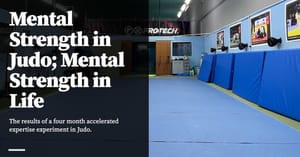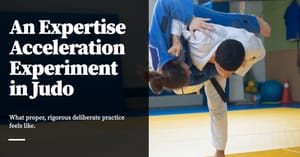A lesson from a four month accelerated expertise experiment. Or: why creating new drills for a deliberate practice training program isn't as difficult as you might think.
This is an essay about the lessons from my Accelerated Expertise Experiment in Judo. I’d recommend reading the prior essay before reading this one.
“Watch the videos,” said my coach, “What do you see?”
I played the video he’d sent over WhatsApp. It was a competition clip. “I see ... a failed throw,” I said, “After which the attacker continues with newaza.” Newaza is the Judo term for groundwork, which meant that the attacker followed up on their failed throw by initiating a pin, an armlock, or a choke on the ground.
This was in late October, before I moved to Kuala Lumpur. My coach had started my training by sending over a bunch of documents and videos via WhatsApp, over a period of a few days.
“Continue watching,” he said, and sent a collection of more videos.
I watched the second video. It showed a different competitor, in a different tournament, doing a failed throw. That competitor followed it up with a newaza attack. And then a third video. And then a fourth. And I realised that what was odd with all of these videos was that all the throws were failing in the exact same way.
“Wait,” I said, “Are these throws failing intentionally?”
“Yes.” My coach said. “And these are not failed throws. These are fake attacks. You’re going to learn how to do this.”
One of the quirks about Judo is that the groundwork component of the sport is seen as less important relative to its standing component. When you watch a Judo match, you mostly see an upright, dynamic fight, whilst a typical Brazilian Jujitsu match looks like two people entangled in some awkward position on the ground.
The rules, of course, are to blame for these differences. In Judo, you win by throwing an opponent onto their back, by pinning them for 20 seconds, by getting a submission from choke or arm-lock, and finally by having your opponent incur three penalties over the course of a match. Judo rules want you to throw, and only reluctantly concede that you may win on the ground — most referees give only a few seconds of play time when a fight enters newaza before calling for a reset. More importantly, though, Judo rules don’t want you to deliberately bring the fight to the ground — which means that you cannot do things like pull guard (the Brazilian Jujitsu term for grabbing hold of your opponent and then sitting on your bum, thus forcing newaza), plus you cannot do a false attack to drag your opponent down on all fours. In other words, modern Judo rules frown on blatant attempts to bring your opponent into groundwork.
But the second order consequences of these rules are perhaps obvious. Over the course of a few decades, competitive judo players and coaches developed non-blatant attempts to bring opponents down into newaza. My coach told me that these are colloquially known as ‘fake attacks’. (As opposed to a ‘false attack’, which do not move your opponent and are penalisable). Fake attacks, he said, may be as distinct and as complex as actual Judo attacks, but were created for very different purposes. These are techniques that are designed to:
- Look like a real throw — enough to not be penalisable.
- Be difficult to counter.
- And have a high success rate of bringing one’s opponent face-first, down onto the ground, with the attacker ending up in an ideal newaza offensive position.
Looking back, it’s a little bizarre to me that I had no idea these techniques existed. Surely it would’ve been obvious, given the ruleset? But I was blind. Before my training, I would see a fake attack in top-level judo competition and think that it was a genuine attempt to throw that just happened to fail, after which the attacker went on the offensive on the ground. It took me some time — and some training — before I could differentiate the fake attacks from the failed real attacks. At which point I learnt that all the top competitors, referees, and coaches on the IJF (International Judo Federation) tour were in on this, and could identify when a throw was intentionally fake, versus when it was an actual attempt that failed.
This was mind blowing to me — it was an aspect of the sport that I had no idea existed. It wasn’t taught in Singapore, where I train today, or in Malaysia, where I learnt Judo as a teenager. My inability to see these techniques was a direct result of my lack of expertise.
“To be fair, fake attacks are not taught in recreational clubs anywhere in the world,” my coach said, when I brought this up with him. “You’ll need to go to one of the top competition training centres. Places like Camberley in the UK, or the Russelsheim Olympic Training Centre in Germany.” Places my coach had spent his early 20s training at.
And why were these techniques not known or practiced in our part of the world?
My coach smiled. “Because they’re not interested,” he said, “This is sport Judo, not classical Japanese Judo, so they’re not interested. Judo is one of the few sports where there is a such a huge gap between what is taught at the club level and what is actually done at the top.”
*
My training started with learning the fake throws from scratch, just like I would any new Judo technique.
“A seoi overshoot is a drop seoinage where you just happen to land next to your opponents legs. A real drop seoinage requires you to land in between your opponent’s legs. Here you do exactly the same thing, but you land in the wrong place. This puts you in an ideal position for a newaza attack.”
Originally published , last updated .
This article is part of the Expertise Acceleration topic cluster. Read more from this topic here→





